Xue Jiang
RL-PLUS: Countering Capability Boundary Collapse of LLMs in Reinforcement Learning with Hybrid-policy Optimization
Jul 31, 2025Abstract:Reinforcement Learning with Verifiable Reward (RLVR) has significantly advanced the complex reasoning abilities of Large Language Models (LLMs). However, it struggles to break through the inherent capability boundaries of the base LLM, due to its inherently on-policy strategy with LLM's immense action space and sparse reward. Further, RLVR can lead to the capability boundary collapse, narrowing the LLM's problem-solving scope. To address this problem, we propose RL-PLUS, a novel approach that synergizes internal exploitation (i.e., Thinking) with external data (i.e., Learning) to achieve stronger reasoning capabilities and surpass the boundaries of base models. RL-PLUS integrates two core components: Multiple Importance Sampling to address for distributional mismatch from external data, and an Exploration-Based Advantage Function to guide the model towards high-value, unexplored reasoning paths. We provide both theoretical analysis and extensive experiments to demonstrate the superiority and generalizability of our approach. The results show that RL-PLUS achieves state-of-the-art performance compared with existing RLVR methods on six math reasoning benchmarks and exhibits superior performance on six out-of-distribution reasoning tasks. It also achieves consistent and significant gains across diverse model families, with average relative improvements ranging from 21.1\% to 69.2\%. Moreover, Pass@k curves across multiple benchmarks indicate that RL-PLUS effectively resolves the capability boundary collapse problem.
A Survey on Code Generation with LLM-based Agents
Jul 31, 2025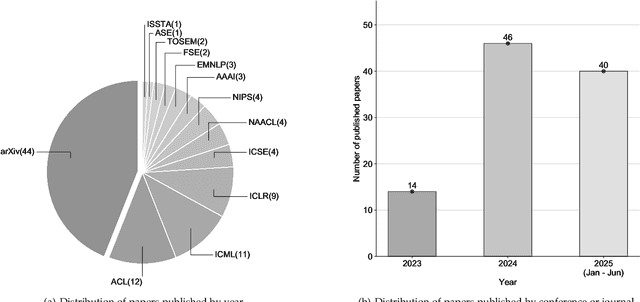
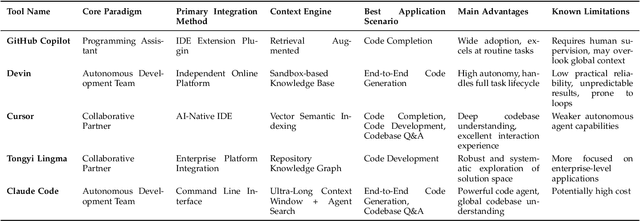
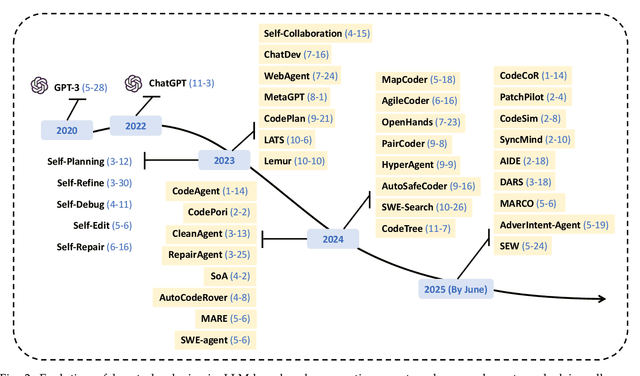
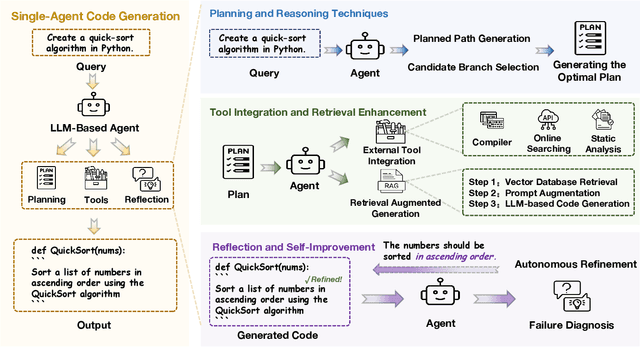
Abstract:Code generation agents powered by large language models (LLMs) are revolutionizing the software development paradigm. Distinct from previous code generation techniques, code generation agents are characterized by three core features. 1) Autonomy: the ability to independently manage the entire workflow, from task decomposition to coding and debugging. 2) Expanded task scope: capabilities that extend beyond generating code snippets to encompass the full software development lifecycle (SDLC). 3) Enhancement of engineering practicality: a shift in research emphasis from algorithmic innovation toward practical engineering challenges, such as system reliability, process management, and tool integration. This domain has recently witnessed rapid development and an explosion in research, demonstrating significant application potential. This paper presents a systematic survey of the field of LLM-based code generation agents. We trace the technology's developmental trajectory from its inception and systematically categorize its core techniques, including both single-agent and multi-agent architectures. Furthermore, this survey details the applications of LLM-based agents across the full SDLC, summarizes mainstream evaluation benchmarks and metrics, and catalogs representative tools. Finally, by analyzing the primary challenges, we identify and propose several foundational, long-term research directions for the future work of the field.
Multi-objective Aligned Bidword Generation Model for E-commerce Search Advertising
Jun 04, 2025Abstract:Retrieval systems primarily address the challenge of matching user queries with the most relevant advertisements, playing a crucial role in e-commerce search advertising. The diversity of user needs and expressions often produces massive long-tail queries that cannot be matched with merchant bidwords or product titles, which results in some advertisements not being recalled, ultimately harming user experience and search efficiency. Existing query rewriting research focuses on various methods such as query log mining, query-bidword vector matching, or generation-based rewriting. However, these methods often fail to simultaneously optimize the relevance and authenticity of the user's original query and rewrite and maximize the revenue potential of recalled ads. In this paper, we propose a Multi-objective aligned Bidword Generation Model (MoBGM), which is composed of a discriminator, generator, and preference alignment module, to address these challenges. To simultaneously improve the relevance and authenticity of the query and rewrite and maximize the platform revenue, we design a discriminator to optimize these key objectives. Using the feedback signal of the discriminator, we train a multi-objective aligned bidword generator that aims to maximize the combined effect of the three objectives. Extensive offline and online experiments show that our proposed algorithm significantly outperforms the state of the art. After deployment, the algorithm has created huge commercial value for the platform, further verifying its feasibility and robustness.
Text-Queried Audio Source Separation via Hierarchical Modeling
May 27, 2025



Abstract:Target audio source separation with natural language queries presents a promising paradigm for extracting arbitrary audio events through arbitrary text descriptions. Existing methods mainly face two challenges, the difficulty in jointly modeling acoustic-textual alignment and semantic-aware separation within a blindly-learned single-stage architecture, and the reliance on large-scale accurately-labeled training data to compensate for inefficient cross-modal learning and separation. To address these challenges, we propose a hierarchical decomposition framework, HSM-TSS, that decouples the task into global-local semantic-guided feature separation and structure-preserving acoustic reconstruction. Our approach introduces a dual-stage mechanism for semantic separation, operating on distinct global and local semantic feature spaces. We first perform global-semantic separation through a global semantic feature space aligned with text queries. A Q-Audio architecture is employed to align audio and text modalities, serving as pretrained global-semantic encoders. Conditioned on the predicted global feature, we then perform the second-stage local-semantic separation on AudioMAE features that preserve time-frequency structures, followed by acoustic reconstruction. We also propose an instruction processing pipeline to parse arbitrary text queries into structured operations, extraction or removal, coupled with audio descriptions, enabling flexible sound manipulation. Our method achieves state-of-the-art separation performance with data-efficient training while maintaining superior semantic consistency with queries in complex auditory scenes.
Rethinking Repetition Problems of LLMs in Code Generation
May 15, 2025Abstract:With the advent of neural language models, the performance of code generation has been significantly boosted. However, the problem of repetitions during the generation process continues to linger. Previous work has primarily focused on content repetition, which is merely a fraction of the broader repetition problem in code generation. A more prevalent and challenging problem is structural repetition. In structural repetition, the repeated code appears in various patterns but possesses a fixed structure, which can be inherently reflected in grammar. In this paper, we formally define structural repetition and propose an efficient decoding approach called RPG, which stands for Repetition Penalization based on Grammar, to alleviate the repetition problems in code generation for LLMs. Specifically, RPG first leverages grammar rules to identify repetition problems during code generation, and then strategically decays the likelihood of critical tokens that contribute to repetitions, thereby mitigating them in code generation. To facilitate this study, we construct a new dataset CodeRepetEval to comprehensively evaluate approaches for mitigating the repetition problems in code generation. Extensive experimental results demonstrate that RPG substantially outperforms the best-performing baselines on CodeRepetEval dataset as well as HumanEval and MBPP benchmarks, effectively reducing repetitions and enhancing the quality of generated code.
Generative Retrieval and Alignment Model: A New Paradigm for E-commerce Retrieval
Apr 02, 2025Abstract:Traditional sparse and dense retrieval methods struggle to leverage general world knowledge and often fail to capture the nuanced features of queries and products. With the advent of large language models (LLMs), industrial search systems have started to employ LLMs to generate identifiers for product retrieval. Commonly used identifiers include (1) static/semantic IDs and (2) product term sets. The first approach requires creating a product ID system from scratch, missing out on the world knowledge embedded within LLMs. While the second approach leverages this general knowledge, the significant difference in word distribution between queries and products means that product-based identifiers often do not align well with user search queries, leading to missed product recalls. Furthermore, when queries contain numerous attributes, these algorithms generate a large number of identifiers, making it difficult to assess their quality, which results in low overall recall efficiency. To address these challenges, this paper introduces a novel e-commerce retrieval paradigm: the Generative Retrieval and Alignment Model (GRAM). GRAM employs joint training on text information from both queries and products to generate shared text identifier codes, effectively bridging the gap between queries and products. This approach not only enhances the connection between queries and products but also improves inference efficiency. The model uses a co-alignment strategy to generate codes optimized for maximizing retrieval efficiency. Additionally, it introduces a query-product scoring mechanism to compare product values across different codes, further boosting retrieval efficiency. Extensive offline and online A/B testing demonstrates that GRAM significantly outperforms traditional models and the latest generative retrieval models, confirming its effectiveness and practicality.
Thinking Longer, Not Larger: Enhancing Software Engineering Agents via Scaling Test-Time Compute
Mar 31, 2025Abstract:Recent advancements in software engineering agents have demonstrated promising capabilities in automating program improvements. However, their reliance on closed-source or resource-intensive models introduces significant deployment challenges in private environments, prompting a critical question: \textit{How can personally deployable open-source LLMs achieve comparable code reasoning performance?} To this end, we propose a unified Test-Time Compute scaling framework that leverages increased inference-time computation instead of larger models. Our framework incorporates two complementary strategies: internal TTC and external TTC. Internally, we introduce a \textit{development-contextualized trajectory synthesis} method leveraging real-world software repositories to bootstrap multi-stage reasoning processes, such as fault localization and patch generation. We further enhance trajectory quality through rejection sampling, rigorously evaluating trajectories along accuracy and complexity. Externally, we propose a novel \textit{development-process-based search} strategy guided by reward models and execution verification. This approach enables targeted computational allocation at critical development decision points, overcoming limitations of existing "end-point only" verification methods. Evaluations on SWE-bench Verified demonstrate our \textbf{32B model achieves a 46\% issue resolution rate}, surpassing significantly larger models such as DeepSeek R1 671B and OpenAI o1. Additionally, we provide the empirical validation of the test-time scaling phenomenon within SWE agents, revealing that \textbf{models dynamically allocate more tokens to increasingly challenging problems}, effectively enhancing reasoning capabilities. We publicly release all training data, models, and code to facilitate future research. https://github.com/yingweima2022/SWE-Reasoner
Universal Speech Token Learning via Low-Bitrate Neural Codec and Pretrained Representations
Mar 15, 2025

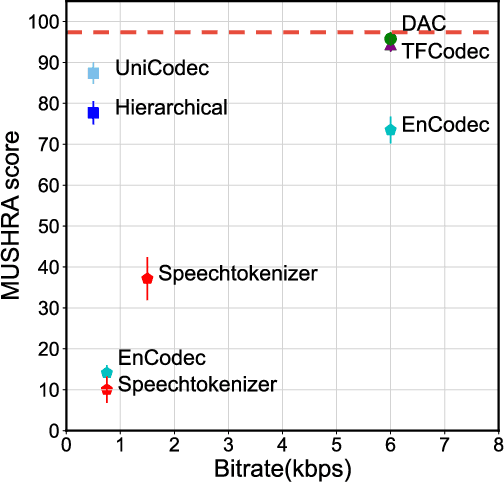

Abstract:Current large speech language models are mainly based on semantic tokens from discretization of self-supervised learned representations and acoustic tokens from a neural codec, following a semantic-modeling and acoustic-synthesis paradigm. However, semantic tokens discard paralinguistic attributes of speakers that is important for natural spoken communication, while prompt-based acoustic synthesis from semantic tokens has limits in recovering paralinguistic details and suffers from robustness issues, especially when there are domain gaps between the prompt and the target. This paper unifies two types of tokens and proposes the UniCodec, a universal speech token learning that encapsulates all semantics of speech, including linguistic and paralinguistic information, into a compact and semantically-disentangled unified token. Such a unified token can not only benefit speech language models in understanding with paralinguistic hints but also help speech generation with high-quality output. A low-bitrate neural codec is leveraged to learn such disentangled discrete representations at global and local scales, with knowledge distilled from self-supervised learned features. Extensive evaluations on multilingual datasets demonstrate its effectiveness in generating natural, expressive and long-term consistent output quality with paralinguistic attributes well preserved in several speech processing tasks.
PrivacyScalpel: Enhancing LLM Privacy via Interpretable Feature Intervention with Sparse Autoencoders
Mar 14, 2025



Abstract:Large Language Models (LLMs) have demonstrated remarkable capabilities in natural language processing but also pose significant privacy risks by memorizing and leaking Personally Identifiable Information (PII). Existing mitigation strategies, such as differential privacy and neuron-level interventions, often degrade model utility or fail to effectively prevent leakage. To address this challenge, we introduce PrivacyScalpel, a novel privacy-preserving framework that leverages LLM interpretability techniques to identify and mitigate PII leakage while maintaining performance. PrivacyScalpel comprises three key steps: (1) Feature Probing, which identifies layers in the model that encode PII-rich representations, (2) Sparse Autoencoding, where a k-Sparse Autoencoder (k-SAE) disentangles and isolates privacy-sensitive features, and (3) Feature-Level Interventions, which employ targeted ablation and vector steering to suppress PII leakage. Our empirical evaluation on Gemma2-2b and Llama2-7b, fine-tuned on the Enron dataset, shows that PrivacyScalpel significantly reduces email leakage from 5.15\% to as low as 0.0\%, while maintaining over 99.4\% of the original model's utility. Notably, our method outperforms neuron-level interventions in privacy-utility trade-offs, demonstrating that acting on sparse, monosemantic features is more effective than manipulating polysemantic neurons. Beyond improving LLM privacy, our approach offers insights into the mechanisms underlying PII memorization, contributing to the broader field of model interpretability and secure AI deployment.
FANformer: Improving Large Language Models Through Effective Periodicity Modeling
Feb 28, 2025Abstract:Periodicity, as one of the most important basic characteristics, lays the foundation for facilitating structured knowledge acquisition and systematic cognitive processes within human learning paradigms. However, the potential flaws of periodicity modeling in Transformer affect the learning efficiency and establishment of underlying principles from data for large language models (LLMs) built upon it. In this paper, we demonstrate that integrating effective periodicity modeling can improve the learning efficiency and performance of LLMs. We introduce FANformer, which integrates Fourier Analysis Network (FAN) into attention mechanism to achieve efficient periodicity modeling, by modifying the feature projection process of attention mechanism. Extensive experimental results on language modeling show that FANformer consistently outperforms Transformer when scaling up model size and training tokens, underscoring its superior learning efficiency. To further validate the effectiveness of FANformer, we pretrain a FANformer-1B on 1 trillion tokens. FANformer-1B exhibits marked improvements on downstream tasks compared to open-source LLMs with similar model parameters or training tokens. The results position FANformer as an effective and promising architecture for advancing LLMs.
 Add to Chrome
Add to Chrome Add to Firefox
Add to Firefox Add to Edge
Add to Edge